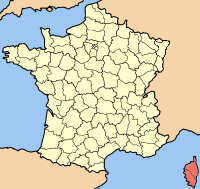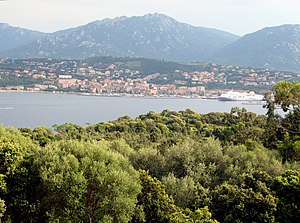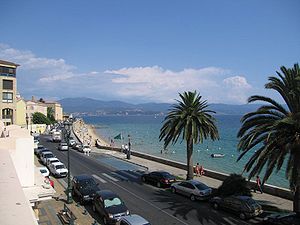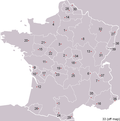Corsica
From Wikipedia, the free encyclopedia
| Corse Corsica |
|||
| Flag | Region logo | ||
|
|||
| Location | |||
 |
|||
| Time zone | CET/CEST (UTC+1/+2) | ||
| Administration | |||
| Country | France | ||
| NUTS Region | FR8 | ||
| Capital | Ajaccio | ||
| President | Ange Santini (UMP) | ||
| Basic statistics | |||
| Area | 8,680 km² (3,351 sq mi) | ||
| Population | 302,000 (01/2008) (Ranked 25th) |
||
| - Density | 35 /km² (90 /sq mi) | ||
| Other information | |||
| GDP/ Nominal | € 6 billion (2006)[1] | ||
| GDP per capita | € 20,300 [1] |
||
| Website | corse.fr | ||
Corsica (French: Corse; Corsican and Italian: Corsica) is the fourth largest island in the Mediterranean Sea (after Sicily, Sardinia, and Cyprus). It is located west of Italy, southeast of the French mainland, and north of the island of Sardinia.
Corsica is one of the 26 régions of France, although strictly speaking Corsica is designated as a "territorial collectivity" (collectivité territoriale) by law. As a territorial collectivity, it enjoys greater powers than other French régions, but for the most part its status is quite similar. Corsica is referred to as a "région" in common speech, and is almost always listed among the other régions of France. Although the island is separated from the continental mainland by the Ligurian Sea and is much closer to the Italian than to the French mainland, politically Corsica is part of Metropolitan France. It was once briefly an independent Corsican Republic, until being incorporated into France in 1768.
Corsica is famed as the birthplace of Napoléon Bonaparte. His ancestral home, Casa Buonaparte, is located there.
Contents |
[edit] History
Corsica has been occupied continuously since the Mesolithic age. It acquired an indigenous population that was influential in the Mediterranean during its long prehistory. After a brief colonization by the ancient Greeks and an only slightly longer occupation by the Etruscans it was preempted by the Roman Republic and became with Sardinia a province of the Roman Empire. After the fall of the empire it was invaded by a number of short-lived powers before being rescued by the March of Tuscany. As a medieval state speaking a Romance language it became an object of contention between the Republic of Pisa and the Republic of Genoa. The Genoese again took possession of the island in 1347, and governed it until 1729 - interrupted only by a brief intervention of the French in 1553.

In 1729 the Corsican Revolution for independence began. After 26 years of struggle the independent Corsican Republic was formed in 1755 under the leadership of Pasquale Paoli and remained sovereign until 1768. The first Corsican Constitution was written in Italian (the language of culture in Corsica until the end of the 19th century) by Paoli. He proclaimed that Italian was the official language of Corsica.
The Corsican Republic was unable to eject the Genoese from the major coastal cities. In 1764 Corsica was purchased secretly by France from the Republic of Genoa. After an announcement and brief civil war in 1768-69, Corsica was incorporated into France in 1770, marking the end of Corsican sovereignty. However, national feelings still run high.
In 1762, Jean-Jacques Rousseau wrote in his opus, The Social Contract, that Corsica would one day astonish Europe.[2] This was written some seven years before Napoleon was born in Corsica.
[edit] Geography

| Native name: Corse Sobriquet: L’Île de Beauté The Isle of Beauty |
|
 Topography of Corsica |
|
| Geography | |
|---|---|
| Location | Mediterranean Sea |
| Area | 8,680 km2 (3,350 sq mi) |
| Length | 183 km (114 mi) |
| Width | 83 km (52 mi) |
| Coastline | 1,000 km (620 mi) |
| Highest point | Monte Cinto (2,706 m (8,880 ft)) |
| Country | |
| Corsica | |
| Région | Corsica |
| Largest city | Ajaccio (63,723) |
| Demographics | |
| Population | 302,000 (as of Jan. 2008) |
| Density | 35 people/km2 |
[edit] Statistics
Corsica is 183 kilometres (114 mi) long at longest, 83 kilometres (52 mi) wide at widest, has 1,000 kilometres (620 mi) of coastline, more than 200 beaches, and is very mountainous, with Monte Cinto as the highest peak at 2,706 metres (8,880 ft) and 20 other summits of more than 2,000 metres (6,600 ft). Mountains comprise 2⁄3 of the island, forming a single chain. Forest comprises 1⁄5. Approximately 3,500 km2 (1,400 sq mi) of the total surface area of 8,680 km2 (3,350 sq mi) are dedicated to nature reserves (Parc Naturel Régional de Corse), mainly in the interior.[3]
The island is 90 kilometres (56 mi) from Tuscany in Italy and 170 kilometres (110 mi) from the Côte d'Azur in France. It is separated from Sardinia to the south by the Strait of Bonifacio, a minimum of 11 kilometres (6.8 mi) wide.[3]
[edit] Major rivers
Corsica has several rivers, some with tributaries. They originate in inland lakes or mountain passes, flow through gorges featuring rapids and waterfalls, then meander through coastal alluvial deposits before discharging into the sea rather than into one of the many coastal étangs or "pools". The rivers and tributaries are as follows:[4]
- Golo (Latin Tavola): From Col de Verghio eastward to the Tyrrhenian Sea south of La Marana; 82 kilometres (51 mi).
- Calasima: From Calasima village; 8 kilometres (5 mi).
- Asco: From Monte Cinto at Asco village; 16 kilometres (9.9 mi).
- Tartagine.
- Casaluna.
- Tavignano; 75 kilometres (47 mi)
- Restonica
- Vecchio
- Manganello
- Fium Orbo
- Travo
- Rizzanese
- Taravo
- Gravona; 45 kilometres (28 mi)
- Prunelli
- Liamine; 40 kilometres (25 mi)
- Fiume Grosso
- Cruzzini
- Porto
- Fango: from a ravine at Paglia Orba northwest to the Gulf of Galéria; 23.7 kilometres (14.7 mi)
- Ostriconi (Corsican Ustriconi): from the hill of Santa Maria on Monte di Reghja Pozzu in Pietralba commune northwest to the Plage d'Ostriconi in the Cove of Perajola and the Désert des Agriates near Isula Rossa; 23.2 kilometres (14.4 mi).
[edit] Major communities
In 2005 the population of Corsica was settled in approximately 360 communities.[5]
[edit] Mountains
Corsica contains the GR20, one of Europe's most famous hiking trails.
[edit] Ecology
[edit] Zones by altitude
The island is divided into three major ecological zones by altitude.[6] Below 2,000 feet (610 m) is the coastal zone, which features a Mediterranean climate, with hot, dry summers and mild, rainy winters. The natural vegetation is Mediterranean forests, woodlands, and shrubs. The coastal lowlands are part of the Tyrrhenian-Adriatic sclerophyllous and mixed forests ecoregion, in which forests and woodlands of evergreen sclerophyll oaks predominate, chiefly Holm Oak (Quercus ilex) and Cork Oak (Quercus suber). Much of the coastal lowlands have been cleared for agriculture, grazing and logging, which have reduced the forests considerably.
From 2,000 to 6,000 feet (610 to 1,800 m) is a temperate montane zone. The mountains are cooler and wetter, and home to the Corsican montane broadleaf and mixed forests ecoregion, which supports diverse forests of oak, pine, and broadleaf deciduous trees, with vegetation more typical of northern Europe. The population lives predominantly below 3,000 feet (910 m), with only shepherds and hikers at 2,000 to 3,000 feet (610 to 910 m).
From 6,000 to 9,000 feet (1,800 to 2,700 m) is a high alpine zone. Vegetation is sparse. In spite of the southern location, the highest elevations are snow-capped with small glaciers. This zone is uninhabited.
[edit] Zones by region
[edit] Parc Naturel Régional de Corse
The island has a natural park (Parc Naturel Régional de Corse, Parcu di Corsica), which protects thousands of rare animal and plant species. The park was created in 1972 and includes the Golfe de Porto, the Scandola Nature Reserve (a UNESCO World Heritage Site), and some of the highest mountains on the island. This park is protected and cannot be reached on foot, but people can gain access by boat. Two endangered subspecies of hoofed mammals, the mouflon (Ovis aries musimon) and Corsican red deer (Cervus elaphus corsicanus) inhabit the island; the Corsican red deer is endemic.
[edit] Extinct animals
Corsica, like all the other Mediterranean islands, was home to indigenous animals of the Pleistocene, some endemic to it and some to it and Sardinia (as Sardinia was joined to Corsica for much of the Pleistocene). After the proliferation of man in the Mesolithic, these began to disappear, partly from extinction of the species, and partly from eradication only from Corsica. Blaming the extinctions on Mesolithic man is now known to be in error, as many survived well into historical times.[7]
The totally extinct species are Cynotherium sardous, Megaloceros cazioti, Soriculus corsicanus, Prolagus sardus, Bubo insularis and Athene angelis. Birds were especially hard-hit. Some that were eradicated from the vicinity are Haliaeetos albicilla and Aquila heliaca.
[edit] Culture
[edit] Language
[edit] Cuisine
The food of Corsica can best be defined as a fusion of the French and Italian cuisines, due to its close geographical positions with the two countries. Popular foods such as pizza, pasta, cured meats and sheep's milk cheeses can be found. Each region within the island has its own take on recipes. In the mountains, wild meat like boar, rabbit, and trout from the many rivers offer variety according to the seasons.
[edit] Administration
The capital of Corsica is Ajaccio (Corsican: Aiacciu). The ruling body is the Corsican Assembly. The territorial collectivity is divided in two départements: Corse-du-Sud and Haute-Corse. These two départements were created on September 15, 1975 by splitting the hitherto united département of Corse.
Recent attempts to gain greater autonomy for the territorial collectivity of Corsica have failed. A local referendum held in 2003, aimed at disbanding the départements and leaving only the territorial collectivity with extended powers, was voted down by a narrow margin.
[edit] Economy

Corsica is the least economically developed region in Metropolitan France.[1] Tourism plays a major role in the Corsican economy. The island's climate, mountains and coastlines make it a popular destination among the French and other Western Europeans. However, the island has not had the same level of intensive development as other parts of the Mediterranean and is thus relatively unspoiled. Tourism is particularly concentrated in the area around Porto Vecchio and Bonifacio in the south of the island and Calvi in the northwest.
In 1584 the Governor of Genua ordered to all farmers and landowners to plant four trees yearly, among which is a chestnut tree (plus an olive-, fig- and mulberry-tree). Many communities owe their origin and former richness to the ensuing chestnut woods.[8] Chestnut bread keeps fresh for as long as two weeks.[9] Corsica produces gourmet cheese, wine, sausages, and honey for sale in mainland France and for export. Corsican honey, of which there are six official varietals, is certified as to its origin (Appellation d'origine contrôlée) by the French National Institute of Origin and Quality (INAO).
[edit] Transport
[edit] Railway
Corsica has 232 kilometers (144 mi) of narrow-gauge railway. The main line runs between Bastia and Ajaccio and there is a branch line from Ponte-Leccia to Calvi. The trains are operated by Chemins de fer de Corse (CFC).
There is also a third line along the east coast that is no longer in use due to heavy damage during World War II. There has been talk of restoring it but as yet nothing has happened.
[edit] Politics
Corsica is currently governed almost as any other région of France, as explained in the introduction. There are several movements on the island calling for some degree of Corsican autonomy from France, or even full independence. Generally speaking, autonomist proposals focus on the promotion of the Corsican language, more power for local governments, and some exemptions from national taxes in addition to those already applying to Corsica.
The French government is opposed to full independence, but has at times shown support for some level of autonomy. There is support on the island for proposals of greater autonomy, but polls show that a large majority of Corsicans are opposed to full independence.
Some groups who claim to support Corsican independence have carried out a violent campaign since the 1970s that includes bombings and assassination, usually targeting buildings and officials representing the French government or Corsicans themselves for political reasons. A war between two rival independence groups led to several deaths in the 1990s. The peaceful occupation of a pied-noir vineyard in Aléria in 1975 marked a turning point when the French government responded with overwhelming force, generating sympathy for the independence groups among the Corsican population. However, events such as the murder of préfet Claude Erignac on February 6, 1998 (for which Yvan Colonna was arrested five years later) have only served to convince many in Corsica, as well as in the French government and the general French public, that Corsican nationalists cannot be trusted with more autonomy.
Some of the independence groups are known to practice extortion and other intimidatory tactics, not dissimilar from mafia activity in Sicily and southern Italy. Non-Corsican homeowners may be threatened with the destruction of their home, which can be avoided only through paying a ransom. Journalists writing articles critical of the armed groups have sometimes been threatened. Prosecutions are made difficult by a pervasive "law of silence". It is sometimes suggested that such behavior could be directly related to longstanding cultural traditions of banditry in the rugged interior of the island.
In 2000, Prime Minister Lionel Jospin agreed to grant increased autonomy to Corsica. The proposed autonomy for Corsica would have included greater protection for the Corsican language (Corsu), the island's traditional language (which is similar to Italian), whose practice and teaching, like other regional or minority languages in France, had in the past been discouraged. According to the UNESCO classification, the Corsican language is currently in danger of becoming extinct. However, plans for increased autonomy were opposed by the Gaullist opposition in the French National Assembly, who feared that they would lead to calls for autonomy from other régions (such as Brittany or Alsace), eventually threatening France's unity as a country.
In a referendum on July 6, 2003, a narrow majority of Corsican voters opposed a project from the government of Jean-Pierre Raffarin and then-Interior Minister Nicolas Sarkozy that would have suppressed the two départements of the island and granted greater autonomy to the territorial collectivity of Corsica.
[edit] Notes
- ^ a b c "GDP per inhabitant in 2006 ranged from 25% of the EU27 average in Nord-Est in Romania to 336% in Inner London". Eurostat. http://epp.eurostat.ec.europa.eu/pls/portal/docs/PAGE/PGP_PRD_CAT_PREREL/PGE_CAT_PREREL_YEAR_2009/PGE_CAT_PREREL_YEAR_2009_MONTH_02/1-19022009-EN-AP.PDF.
- ^ Rousseau, J-J., "The Social Contract", Chapter 10: "There is still in Europe one country capable of being given laws — Corsica. The valour and persistency with which that brave people has regained and defended its liberty well deserves that some wise man should teach it how to preserve what it has won. I have a feeling that some day that little island will astonish Europe."
- ^ a b Price, Gillian. Walking on Corsica: Long-Distance and Short Walks. Cicerone Press Limited. p. 9. ISBN 1-85284-387-x.
- ^ Dawson, Simon; Edward Carpenter. "Corsica River Guide". http://www.simondawson.com/crsindx.htm.
- ^ Keyser, William (2005). "Corsican Villages and Towns" (pdf). Corsica Isula. http://www.corsica-isula.com/downloads/Corsican_Villages_and_Towns.pdf. Retrieved on 2008-04-29.
- ^ Gregory, Desmond (1985). The ungovernable rock: a history of the Anglo-Corsican Kingdom and its role in Britain's Mediterranean strategy during the Revolutionary War, 1793-1797. London: Fairleigh Dickinson University Press. p. 16. ISBN 0838632254.
- ^ MacPhee, R.D.E.; Hans-Dieter Sues (1999). Extinctions in Near Time: Causes, Contexts, and Consequences. Springer. p. 179. ISBN 0306460920.
- ^ The Chestnut Tree in terracorsa.
- ^ The Grocer's Encyclopedia - Encyclopedia of Foods and Beverages. By Artemas Ward. New York. 1911.
| This article needs additional citations for verification. Please help improve this article by adding reliable references (ideally, using inline citations). Unsourced material may be challenged and removed. (April 2008) |
[edit] Bibliography
- Loughlin, John. 1989. "Regionalism and Ethnic Nationalism in France: A Case-study of Corsica". Thesis. San Domenico, Italy: European University Institute.
- Loughlin, John, and Claude Olivesi (eds.). 1999. Autonomies insulaires: vers une politique de différence pour la Corse. Ajaccio: Editions Albiana. ISBN 2905124474
- Saul, John Ralston. 1992. Voltaire's Bastards: The Dictatorship of Reason in the West. New York: Free Press; Maxwell Macmillan International. ISBN 0029277256
[edit] See also
[edit] External links
| Wikimedia Commons has media related to: Corsica |
- Costa, L.J.; Cécile Costa (2005). "Préhistoire de la Corse" (html). Kyrnos Publications pour l'archéologie. http://www.prehistoire-corse.org/. Retrieved on 2008-04-26. (French)
- Dumas, Alexandre (1845, 2003). "The Corsican Brothers" (html). Arthur's Classical Novels. http://arthursclassicnovels.com/arthurs/dumas/corsic10.html. Retrieved on 2008-04-27. (English)
- Corsica at the Open Directory Project (English)
- "Corsica" (html). Wikitravel. 2008. http://wikitravel.org/en/Corsica. Retrieved on 2008-04-26.
- "National Geographic Magazine: Corsica Map" (html). National Geographic Society. 2003. http://yellowbordermagazine.com/ngm/0304/feature3/map.html. Retrieved on 2008-05-05.
- "Corsica rejects autonomy offer by Paris" (html). CNN.com. July 6, 2003. http://www.cnn.com/2003/WORLD/europe/07/06/corsica.poll/index.html. Retrieved on 2008-04-26.
- Keyser, Will. "Corsica from the inside!" (html). Corsica Isula. http://www.corsica-isula.com. Retrieved on 2008-04-26.
- Lohninger, Hans (2004). "PhotoGlobe: Photos - Corsica" (html). http://www.photoglobe.info/db_corsica/index.html. Retrieved on 2008-04-26.
|
||||||||
|
||||||||||||||








